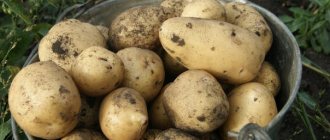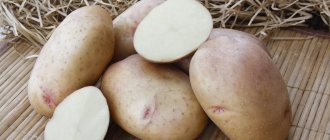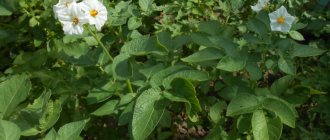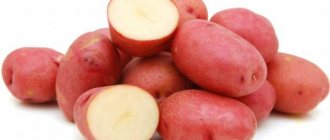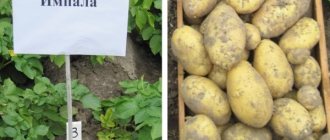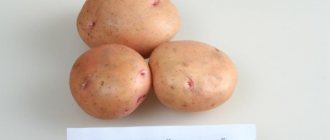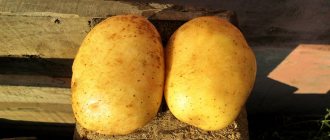Description of the potato variety Karatop
The root crop has been included in the register of breeding achievements of the Russian Federation since 1998. Recommended for cultivation in the Volga-Vyatka, North-West, West Siberian and Middle Volga regions.
The plant is medium-sized, up to 60 cm high. The bush consists of 2-4 stems, moderately spreading. Surface shoots are erect, slightly branched. The foliage is medium in size, slightly wavy along the edges of the plates, and dark green in color.
The buds on the Karatop potato are few. The flowers are white, small, up to 2 cm in diameter.
The bush has a well-developed root system of 12-20 tubers
The fruits of the Karatop variety are small in size, oval-round in shape. The average weight of tubers is 50-80 g, and the maximum is 105 g. The peel is smooth, light yellow. The eyes are small, almost invisible, superficial. Thanks to their smooth skin and regular shape, the tubers can be mechanically cleaned.
Important! The pulp contains no more than 14% starch.
“Karatop” is classified as a medium-boiled variety. The pulp is light yellow and does not darken during heat treatment.
Taste qualities of Karatop potatoes
The fruits retain their firm structure when cooked. The pulp has a pleasant taste, without bitterness. Due to its moderate starch content, the variety can be used for making purees.
“Karatop” should not be consumed before its ripening period. Young potatoes contain pigment substances and an insufficient amount of liquid, which affects the taste. Therefore, the vegetable is recommended for consumption only after ripening.
Breeding instructions
Karatop potatoes can be used for both industrial and home garden cultivation. If it is bred en masse on an industrial scale, the following units are used:
- For soil cultivation - plows, as well as harrows, cultivators or diskers.
- Seeders.
- Hillers.
- Irrigation systems (sprinkler or drip).
- Cleaning units.
Important! In the household, there are enough hand tools or attachments for walk-behind tractors or mini-tractors.
Preparation
plot
The soil for Karatop must be prepared in the fall.
- Full-scale loosening is carried out (for manual digging - no less than 30-40 cm (shovel bayonet); if possible, it makes sense to loosen by two bayonets with temporary removal of the top layer and backfilling it after digging the bottom).
- Organic fertilizers are added - compost, humus, etc. When digging, organic matter is evenly mixed with the soil.
- In the spring, the area is loosened by 15-20 cm (in the garden - by half a bayonet, on an industrial scale - to the depth of embedding with a harrow or diskator). If possible, apply half a kilo of humus, compost, and ash per bush.
Semyan
Seeds are selected in advance during the autumn harvest. Select identical tubers no smaller than a chicken egg without damage or disease.
At least a month before planting, the tubers are germinated in a light and warm storage. Germinated potatoes are used, those that did not produce tubers are disposed of. Additionally, you can use “Prestige” or other chemicals with a similar effect to accelerate growth. It is also permissible to use potassium permanganate, Bordeaux mixture or copper sulfate solution to combat fungal pests.
When to plant?
Karatop potatoes need to be sown when the soil temperature, measured 10 cm from the surface, does not drop less than +7-8 degrees within 24 hours (artificial heating of beds outside greenhouses makes no sense!). Usually this time comes according to the calendar like this:
- Far Eastern region - after the 15th of May.
- Northern, East Siberian, West Siberian - after May 25 or before June 5.
- Northwestern - from May 15 to 25.
- North Caucasus region – the first days (until 10) of April.
- Central Chernozem, Volga-Vyatka, Middle Volga - until May 10-12.
- Central region and Kaliningrad region - the first ten days of May.
Scheme
Potatoes Karatop are planted according to the following scheme:
- There should be at least 70 cm between the rows in order to be able to fully hill up the beds.
- Between bushes in a row - at least 30 cm.
- Depth – from 4 to 8 cm.
- Hilling. It begins when the stems reach at least 10-12 cm in height. Before this time, hilling can be used if there is a threat of spring return frosts.
- Watering. It should be carried out regularly, at least 3-4 times per season. On average, you need to water once every 7-10 days.
- Loosening. During the growing season, loosening is carried out regularly every 7-10 days.
- Weeding. You need to weed as the weeds grow, at least 3-4 times per season.
- Feeding. The first feeding is done when the buds are formed on the bushes with a mixture of the following composition:
- 20 g of ash (wood or vegetable).
30 g potassium sulfate.
- One and a half buckets of water heated to 30 degrees or more.
- Other care measures. If possible, Karatop beds should be covered with mulch from freshly cut grass.
Feeding consumption is about half a liter for each bush.
From the beginning of the appearance of inflorescences, 500 mg of infusion from 2 tbsp is added to each bush. spoons of superphosphate and 250 g of manure per bucket of water.
Characteristics of the potato variety Karatop
The root crop does not have high frost resistance. Therefore, the Karatop variety is not suitable for growing in regions with prolonged frosts. Surface shoots can tolerate temperatures down to -2 degrees. The preservation of fruits in the soil during frost varies depending on the degree of soil warming.
The variety "Karatop" is classified as drought-resistant. Tubers develop normally without additional watering. When the soil is waterlogged, the fruits do not crack. The peel remains smooth, without roughness.
Tubers tolerate transportation normally without losing their marketable appearance. The “Karatop” variety is characterized by high keeping quality – 97%. Potatoes are suitable for long-term storage.
The root vegetable is considered universal, as it can be used for almost any culinary purpose. Potatoes are good for frying, baking and as an ingredient in salad or soup. During heat treatment, the root vegetable does not crumble and retains its color, making the finished dishes look very appetizing.
Productivity
The average is 300 kg per hundred square meters. From 1 hectare you get up to 500 centners of root crops. The ripening period for the Karatop variety is 50 days.
1.5-2 kg of potatoes are harvested from one bush
Productivity depends on the following factors:
- quality of seed material;
- soil condition;
- distance between bushes;
- air temperature;
- presence of pests.
For 1 sq. m. plot, you can place 5-6 “Karatop” potato bushes. Therefore, the maximum yield per 1 sq. m. – up to 12 kg.
Advantages and disadvantages
"Karatop" has many advantages over other potato varieties. Therefore, the root crop is valued by domestic farmers and is often used for industrial cultivation.
The stalks of the Karatop potato do not dry out due to the heat
pros
- compactness of bushes;
- high productivity;
- low demands on soil;
- drought resistance;
- disease resistance;
- high keeping quality;
- possibility of transportation;
- ease of care.
Minuses
- susceptibility to certain pests;
- low winter hardiness.
Harvest time and storage
Karatop can be harvested several times per season. The first harvest usually begins between 45 and 60 days from planting. Productivity depends on the region, on average, the first harvest can be 35 t/ha, and with further harvest - 50 t/ha.
The storage room for the crop should be dry, cool and dark. Before storing potatoes, vegetables must be thoroughly sorted and dried.
The Karatop variety has many advantages, including early ripening, unpretentiousness and high yield. Those who grow it in their plots note its excellent taste, as well as the fact that it is suitable for preparing various dishes.
Landing rules
Before sowing, it is necessary to sort through the seed potatoes and remove damaged or rotten tubers. It is recommended to spray the fruits with a fungicide to prevent infection.
Proper processing of potatoes before sowing:
Important! Medium-sized tubers are best suited as planting material.
3 weeks before planting, seed potatoes are left indoors at a temperature of +16-18 degrees. After 10-12 days, sprouts will appear from the eyes.
For planting, it is necessary to prepare the site in advance. In the fall, they dig it up and add compost or manure. In spring, the soil is loosened and cleared of weeds.
Landing algorithm:
- They dig furrows 20-25 cm deep.
- Seed potatoes are placed at a distance of 30-40 cm.
- A small amount of wood ash is added along with the tubers.
- The fruits are sprinkled with loose soil on top.
Recommended distance between rows – 60 cm
With proper planting, the first shoots appear after 7-10 days. From this moment the formation of root tubers begins.
How to plant potatoes correctly
This type of potato has no special requirements for planting. However, it is recommended to prepare the soil for it in advance. It is advisable to dig up the soil in the fall and add compost, wood ash and superphosphate in the process.
Crop rotation rules
Good predecessors for potatoes are green manure: peas, beans, mustard, oats, barley, etc. Such plants enrich the soil with useful chemical elements, improve the soil structure, and also inhibit the growth of weeds.
Before planting potatoes, nightshades such as peppers, eggplants, and tomatoes must not have previously grown in the same area. This increases the likelihood of diseases characteristic of nightshades, especially late blight, to which this potato variety is extremely unstable.
After harvesting, the soil balance should be restored by sowing with green manure and applying complex fertilizers.
Important! Next year it is not recommended to plant potatoes in the same place again.
Landing dates
Planting usually begins in mid-April. But it is worth considering that the ground must warm up to a depth of 10 cm. This variety can be used for planting under film. Then planting can begin in mid-March.
Soil requirements
This potato is undemanding to soil. The exception is soils with a granulometric composition, i.e., containing particles of different sizes in the soil, which can affect fertility. In this case, it is necessary to provide additional nutrition and care for the crop.
Preparation of planting material
To achieve rapid ripening of the crop, as well as to obtain stronger plants, it is recommended to germinate the planting material in advance. It is worth choosing medium-sized tubers with a large number of eyes, which will later produce many shoots. Tubers should be taken dense, with a clean, smooth surface, which indicates the absence of diseases.
Direct germination occurs like this:
A small layer of moist soil is poured into the container, the temperature of which should not be lower than +15°C. Then lay out the tubers with their eyes facing up. The soil is again poured on top (2–3 cm). After this, you can lay out the next layer of potatoes.
It is important that there are no more than 3 layers of tubers in the container. For better germination, you can use copper sulfate in a proportion of 1 g per 5 liters of water, the solution of which is watered over the planted tubers. The container is placed in the light and germinated for about 2 weeks. All sprouted tubers are planted, the rest can continue to be sprouted.
Landing technology
To plant, you need to dig a trench. On light soils its depth should be up to 10 cm, in heavy soils - up to 8 cm, for clay soils - up to 5 cm. The distance between rows should be at least 60 cm. The tubers are laid out in a hole 35 cm apart and sprinkled with earth. You can first add humus or ash to the bottom of the trench as additional fertilizing.
Did you know? Homeland of potatoes
—South America. Wild potatoes still grow there.
If planting is organized under film, then before planting, in addition to the usual growing procedure, you need to keep the tubers for a week in a box with peat. Sprouted potatoes are ready for planting if they have shoots 2–3 cm long.
Features of cultivation
The variety "Karatop" is unpretentious in care. When growing, agricultural technology that is standard for most types of potatoes is used, which includes several mandatory procedures.
The variety is drought resistant. But if there is a long absence of rain, the bushes must be watered. Each requires 4-5 liters of liquid, preferably settled.
Important! Potatoes should not be watered with cold water, as this will lead to a deterioration in the condition of the fruit.
Watering is carried out 2-3 times per season. The procedure must be accompanied by loosening the soil and mulching. These procedures improve the air permeability of the soil and increase humidity.
The following is used as mulch:
- tree bark and sawdust;
- dry manure;
- straw;
- compost.
When growing Karatop potatoes, you need to keep the area clean. There should be no weeds around the bushes. They interfere with the development of root tubers and can also attract pests. Therefore, weeds are removed as they appear using a hoe or by hand.
If potatoes are grown in a greenhouse or under a film cover, you need to monitor the air temperature. It should not exceed 40 degrees. Otherwise, tuber growth slows down.
The Karatop potato variety responds well to fertilizing. But you should not overuse fertilizers, as this will negatively affect the condition of the tubers.
Complex mineral compositions characterized by high digestibility are recommended for feeding. It is advisable to apply organic fertilizers only when planting. In the future, this is not done, since the potatoes ripen very quickly.
Advice from experienced gardeners and reviews about the Karatop variety
Most gardeners are satisfied with the Karatop variety. In this section, farmers share their experience and recommendations for growing.
Pavel Terentyev, Samara: “I have been growing potatoes for many years. Several seasons ago I tried to plant the Karatop variety for the first time. When purchasing, I was told that this is an early ripening variety, ripening in 60 days with sufficient watering. To be honest, I didn’t even believe it right away, but two months after planting, my family and I (to my surprise) reaped a very good harvest. The potatoes turned out to be of good quality and very tasty. The harvest lasted almost until summer. Since then I have recommended these potatoes to everyone I know.
I recommend storing potatoes directly in the garden if weather conditions allow it. This method will be useful for gardeners who do not have a cellar or have little space in the house. To do this, dig a hole of medium depth, cover the bottom with dense material, and sprinkle the potatoes on top with earth, straw or spruce branches. Karatope is well stored, which allows it to be placed in the ground.”
Nikolay Donchenko, Belgorod: “ In order not to use chemicals, you can use citrus peels to protect against the ubiquitous Colorado potato beetle. The pest cannot stand their smell, but it will come in handy for the gardener. To make the product, you need to boil dry or fresh peels of orange, tangerine or lemon, and then spray the bushes and the ground around with the cooled broth. It is better to carry out the procedure several times over the summer, especially if there are a lot of beetles in the area. The method is proven and effective."
Anastasia Zharkova, Rostov-on-Don: “I learned about Karatop by accident when I was choosing potatoes to plant. I wanted to plant something new and unusual. At the market they advised me to take this variety; they said that with regular watering it can grow in any soil (and I just have sand in my garden). They also praised it for its early ripening, saying it ripens in 2 months. I didn’t expect, of course, that I would get a harvest so quickly, but after 65 days I harvested a basement full of potatoes. Karatop's tubers are strong, round, and store well. All relatives appreciated the taste. It was only difficult to water frequently, but the result was worth it. I strongly recommend that all gardeners try this variety.”
Ivan, Krasnodar: “Try to plant potatoes so that the beds grow from north to south. So the sun will illuminate the plantings in the morning from the east, and in the afternoon - from the west. Potatoes will be able to receive maximum light and heat, which will have a positive effect on yield.”
Pests and diseases
The Karatop variety is resistant to most fungal diseases. For prevention, the plant is sprayed once before flowering to prevent the development of infection.
The variety exhibits resistance to the following diseases:
- late blight of tubers;
- rhizoctoniasis;
- blackleg;
- leaf roll virus;
- scab;
- potato cancer.
Late blight of tops is considered a common disease. Therefore, despite resistance to other infections, preventive treatment of tubers is necessary when planting bushes before flowering.
The Karatop variety is susceptible to the following pests:
- Colorado beetle;
- wireworm;
- mole cricket;
- potato moth;
- aphid;
- May beetle larvae.
Leaf-eating larvae can be collected from bushes by hand
You need to spray potatoes against pests in the morning or evening. Treatment is carried out at intervals of 2-3 days until the insects completely disappear. It is prohibited to spray the bushes 2 weeks before harvesting, as the components of the insecticide may penetrate the tubers.
Advantages and disadvantages of the variety
According to positive reviews from vegetable growers who grow this variety, potato Krepysh has the following advantages:
- ü Early ripening of tubers - the first digging of the crop can be done 30-40 days after planting,
- ü Abundant harvest (up to 15-20 large potatoes per bush, up to 3 centners per hectare of planting),
- ü Drought resistance. With irregular watering, but with mulching of the soil, excellent plant growth is observed without loss of elasticity and premature wilting,
- ü Excellent taste. The low starch content and low cooking allow you to prepare many delicious dishes, including French fries, casseroles,
- ü Good transportability,
- ü Keeping quality. Subject to storage conditions and optimal air temperature and humidity in the cellar, shelf life is up to 97%,
- ü Resistance to nematode, potato blight, rictonia, scab.
Experienced vegetable growers highlight the following disadvantages:
- ¾ The need for an additional second hilling,
- ¾ Dependence of yield on fertilizing, loosening, watering, hilling,
- ¾ Possibility of damage to the crop due to insufficient drying before storage,
- ¾ Weak immunity to late blight.
Note. Compliance with the recommendations of breeders when planting and choosing soil, care and timely watering, regular fertilizing with organic and mineral fertilizers will help increase productivity and avoid damage to the crop. The positive characteristics of the variety, simple agrotechnological planting conditions, excellent quality of potatoes, good keeping quality and transportability win the hearts and places for planting of both experienced and novice vegetable growers
The positive characteristics of the variety, simple agrotechnological planting conditions, excellent quality of potatoes, good keeping quality and transportability win the hearts and places for planting of both experienced and novice vegetable growers.
Care
Further care for potato plantings includes:
- Loosening. Be sure to regularly loosen the soil between the beds. This procedure will prevent the appearance of weeds, retain moisture and make the soil “light”. The first time is loosened five days after planting. Subsequent loosening is determined by the condition of the soil and weather conditions;
- Hilling. This will protect young shoots from the possible influence of negative factors (threat of return frosts). The seedlings are sprinkled with peat crumbs in a layer of 4 cm;
REFERENCE: Potatoes damaged by frost are fed using nitrogen fertilizers.
- Watering. Potato plantings are thoroughly watered once every seven days. Water five times until the first flowers appear. Watering is combined with fertilizing;
- Feeding. At the beginning of the growing season and before flowering, early potatoes need a large amount of phosphorus. After flowers appear, fertilizers with phosphorus are not needed. During this period, potatoes require potassium, as it improves the quality characteristics of the future harvest.
Highly resistant varieties
Potatoes damage the most:
- Colorado beetle
- late blight
- golden nematode
Enemy #1
Fungal diseases and plant pests can destroy ½ of the crop. Therefore, it is necessary to grow plant varieties that are more resistant to diseases and insects.
In regions with a lot of rain, plants are most often susceptible to fungal diseases. It is recommended to plant the following varieties.
Sap
Sap
Domestic selection. With an average ripening period. The flowers are purple. The potatoes are yellow, creamy when cut. Weight – up to 150 g.
May contain up to 19% starch. The average yield is 16 t/ha.
Borodyansky pink
Borodyansky pink
Early. The tuber is pink. The pulp is creamy. Weight – up to 130 g. Starch content – up to 17%. High-yielding – up to 45 t/ha.
Chervona rue
Chervona rue
Originally from Ukraine. Pink potatoes with white flesh. Starch content – up to 19%.
To this list you can add the varieties described above - Bellarosa and Arosa.
All of them are resistant to late blight.
Tubers with thick skins are less susceptible to damage by plant pests.
Sante
Sante
The average weight of one potato is 120 g. Yellow. One bush gives up to 20 pieces. Contains a small amount of starch - from 10%. With an average ripening period. Productivity – 27 – 50 t/ha.
Vineta
Vineta
German selection. Early. Potatoes are brown. Inside is light brown. Weight – up to 140 g. Starch content – up to 15%. High-yielding – up to 20 t/ha.
Chervona rue and Bellarosa are also pest resistant.
Karatop
Karatop
Early. With yellow skin and light flesh. Contains up to 15% starch. The maximum weight of one potato is up to 130 g. Productivity is up to 52 t/ha.
Fantasy
Fantasy
Red potatoes with white flesh. One plant produces up to 11 pieces. Can be grown in any region of Russia. Late ripening. High-yielding – up to 52 t/ha.




